
Andy Lloyd's Dark Star Blog

Blog 65 (August 2018)
The Moon's Bombardment and Volcanism Combo
The Earth's surface is subject to great change over geological time periods, due to the movement of tectonic plates, and volcanic activity, as well as long-term weathering and erosion. As a result, craters caused by meteorite, asteroid and comet bombardment long ago is gradually eradicated. We therefore look to the Moon's cratered surface to provide clearer evidence of the bombardment history of the Earth/Moon binary. That cratering history is then compared to other planets and objects in the inner solar system, allowing astronomers to discern patterns in cratering over long time periods.
Image credit: NRC, adapted from (2)
One of the most significant events is the late, heavy bombardment. Following a period of relative quiet after the formation of the planets, this mass bombardment was thought to have occurred about 3.9 billion years ago:
"Competing models of meteorite-impact rate for the first 2 billion years (Ga) of Earth and Moon history. Note that Earth is believed to have formed about 4.55 Ga before present. Two hypotheses are shown: exponential decay of impact rate (dashes); and cool early Earth–late heavy bombardment (solid curve)." [see right-hand graph] (1).
More recently however, there has been a gradual realisation that this was not a sudden, dramatic event, but rather a sustained period of impacts by what were some colossal bodies:
"Recent high-resolution orbital data and images, more refined techniques for studying small lunar, terrestrial, and other impact samples and a better understanding of their ages, and improved dynamical models based on orbital and sample data have caused a paradigm shift in how we think about the lunar impact rate ... The long-held idea of a “lunar cataclysm” at ~3.9 Ga is being replaced by the idea of an extended lunar bombardment from ~4.2 Ga to 3.5 Ga." (3)
In the same way that Mars appears to have had both its magnetic field and, subsequently, its atmosphere stripped away, there is also a strong possibility that the Moon looked very different during its early period than it does now. Our close cratered neighbour may once have had an atmosphere (4), although not a particularly pleasant one. Between 4 and 3 billion years ago, the Moon was spewing out a variety of gases from the volcanic activity that filled the lunar 'seas', and these accumulated across the surface to provide a weak atmosphere:
"The atmosphere was thickest during the peak in volcanic activity about 3.5 billion years ago and, when created, would have persisted for about 70 million years before being lost to space. The two largest pulses of gases were produced when lava seas filled the Serenitatis and Imbrium basins about 3.8 and 3.5 billion years ago, respectively." (5)
It is interesting to note that this period of lunar volcanism occurs around the same period as what is now considered to be an extended period of bombardment. Volcanism begins shortly after the start of this prolonged period of dramatic cataclysmic activity. The peak atmospheric pressure on the Moon is reached towards the end of the late, heavy bombardment, around 3.5 billion years ago. Following the return to 'normal' conditions within the solar system, the lunar volcanism tails off, and the atmosphere is gradually lost. It seems that the lunar volcanic activity, lava flow across the lunar surface, and release of gases into the Moon's thin atmosphere, is a reactive response from within the Moon itself to collisional bombardment across the surface. This makes some sense, as many of these strikes were truly awesome in scale, melting significant chunks of real estate. Below the lunar surface, another layer of deeper, subsurface craters is now recognised, indicating that our battered neighbour has a truly fractured and pulverised crust (6).
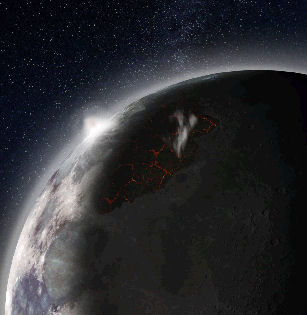
Image Credit: NASA MSFC
There are many possible causes for a short period of bombardment: comet showers, the influx of interstellar materials as the Sun passes through a nebula, a stellar flyby. Explaining a prolonged period of bombardment, which arises from nothing and lasts ~700 million years is more problematic. It speaks to a significantly different environment within the inner solar system itself, where the Earth/Moon binary encounters objects at a frequency that is orders of magnitude above normal. This is one of the reasons why various models of planetary migration have been suggested, mostly involving significant shifts in position by the solar system's big planetary players, like Jupiter, and Neptune. However, I am interested in a very different possibility: Was this prolonged catastrophism, and subsequent period of lunar volcanic activity, instead due to the inward migration of the Moon/Earth system itself?
I suggest that an encounter with another rogue planet jolted our world onto a new, inner track, and spilt a huge amount to materials across the inner solar system. The perilous journey undertaken by the inner planets through this massive debris field created the late, heavy bombardment. Eventually, the planets cleared their domains of much of this asteroidal detritus, and settled down into the orbits we see today. The Moon provides a snapshot of this cataclysmic history.
The approximate content of Earth's early atmosphere has been determined by studying zircon crystals (7). These are igneous minerals which predate Earth rocks. Some are almost as old as the Earth itself. Much can be inferred from their composition about the prevalent conditions during their formation (8). The early Earth's atmosphere was generated by outgassing from lava melts from surface volcanic activity. By the time of the late, heavy bombardment, the Earth's atmosphere was not dissimilar to how it is now (7). It contained oxygen-rich compounds like carbon dioxide and sulphur dioxide, as well as water.
Image Credit: Andy Lloyd
The composition of the Earth and the Moon are very similar - the Moon likely having formed early on as a result of an planetary impact between Earth and a Mars-sized body. It should come as no shock that the Moon also has ancient zircon crystals:
"Lunar zircons are thought to form in the lunar magma ocean's potassium, rare-Earth elements and phosphorus (KREEP) reservoir. And because this reservoir formed towards the end of the magma ocean's hardening, they provide handy objects to determine when solidification took place. Using a technique called isotope dilution thermal ionisation mass spectrometry – an incredibly sensitive technique that can accurately measure minute amounts of elements such as lead and uranium – [Melanie] Barboni [from the University of California, Los Angeles] and her crew found the zircon fragments crystallised between 50 and 60 million years after the birth of the solar system." (9)
In the same way that zircon crystals can help to infer the atmospheric conditions prevalent on the early Earth, lunar zircon crystals should be able to spill the beans on the early lunar atmosphere which, quite possibly, dated back almost 4.5 billion years. In other words, early outgassing may have occurred on the Moon as well as the Earth, providing a binary planetary system sharing many key characteristics, including an early, oxygenated atmosphere. Some of the lunar rocks contain zircon crystals, making such research feasible right here on Earth. Similar analyses have been carried out with zircon crystals found in a meteorite which originated from Mars, known as NWA 7533. The zircon grains in question are 4.43 billion years old (10).
My bet is that the Moon had an atmosphere which pre-dated the late, heavy bombardment, and may have been similar to the Earth's at that time. If the Earth/Moon binary was located further away from the Sun during that early period, perhaps at about 3 astronomical units, then that lunar atmosphere might have been viable at the time, becoming catastrophically depleted only when relocated closer to the Sun.
Written by Andy Lloyd,
6-10th August 2018
References:
1
) National Research Council "The Scientific Context for Exploration of the Moon", The National Academies Press, 2007,2) J.W. Valley et al. "A cool early Earth" Geology, 30(4): pp351-354, 2002
geoscienceworld.org/gsa article
3) N. Zellner "Cataclysm no more: New views on the timing and delivery of lunar impactors" 2017
4) D. Needham & D. Kring "Lunar volcanism produced a transient atmosphere around the ancient Moon" Earth and Planetary Science Letters, 478, 15 November 2017, pp175-178
5) Lunar and Planetary Institute "New NASA Study Shows Moon Once Had an Atmosphere" 5th October 2017, with thanks to Mark
6) Jennifer Chu "Moon’s crust as fractured as can be: Study finds barrage of small asteroids shattered moon’s upper crust", 10 September 2015
7) Rensselaer Polytechnic Institute. "Setting the stage for life: Scientists make key discovery about the atmosphere of early Earth", 30th November 2011
8) Dustin Trail, E. Bruce Watson, Nicholas D. Tailby. "The oxidation state of Hadean magmas and implications for early Earth’s atmosphere", Nature, 2011; 480 (7375)
9) Belinda Smith "Apollo 14 gems reveal moon is 4.51 billion years old" 12 January 2017
10) A. Nemchin et al. "Record of the ancient Martian hydrosphere and atmosphere preserved in zircon from a Martian meteorite". Nature Geoscience, 2014, 7: pp638-642,
Sub-Brown Dwarf's Massive Magnetic Field
A massive free-floating planet located some 20 light years away has been found to have an extraordinarily powerful magnetic field. The object, designated SIMP J01365663+0933473, has a mass (at 12.7 Mj) which is on the border of planet and brown dwarf. This 'inbetweener' status makes it the subject of intense scrutiny. It is now known to be a free-floating object, moving through interstellar space detached from any star. The object has a surface temperature of about 825 degrees Celsius. It also appears that the object is on the planet side of the border-zone, making it a free-floating sub-brown dwarf, or planetary mass object (2).
Image Credit: Caltech/Chuck Carter; NRAO/AUI/NSF
Recent work carried out on new data from the Very Large Array (VLA) telescope in New Mexico indicated that SIMP J01365663+0933473 has an extraordinary magnetic field for an object of this mass. Its magnetic field strength is about 200 times that of Jupiter, and it exhibits a strong aurora despite its solitary existence (1). SIMP J01365663+0933473 has been emitting some very strong auroral radio emissions recently, in keeping with free-floating brown dwarfs. The mechanism for such auroral displays is still not well understood, but provides a useful means for tracking these tricky-to-spot objects down:
"Subsequent observations showed that some brown dwarfs have strong auroras, similar to those seen in our own Solar System’s giant planets. The auroras seen on Earth are caused by our planet’s magnetic field interacting with the solar wind. However, solitary brown dwarfs do not have a solar wind from a nearby star to interact with. How the auroras are caused in brown dwarfs is unclear, but the scientists think one possibility is an orbiting planet or moon interacting with the brown dwarf’s magnetic field, such as what happens between Jupiter and its moon Io." (1)
The current study involved five brown dwarfs/sub-brown dwarfs, or variable ages. Although it provides additional data about the field strength of these objects, it is evident that strong conclusions about what drives these strong magnetic fields remain elusive:
"...we find that age, mass, and temperature together cannot account for the strong magnetic fields produced by our targets." (2)
As far as the impact of these studies on the potential for an old sub-brown dwarf out there somewhere in the outer solar system, then the potential for such auroral displays provides the potential for auroral light emission from such a 'Dark Star', potentially driven by the presence of a substantial moon. The issue, then, would be balancing that against the rise in such an object's detectability given its relatively high radio emissions.
Written by Andy Lloyd,
5th August 2018
References:
1
) National Radio Astronomy Observatory Press Release "VLA Detects Possible Extrasolar Planetary-Mass Magnetic Powerhouse: Object is at boundary between giant planet and brown dwarf" 2nd August 20182) Kao, M. et al. "The Strongest Magnetic Fields on the Coolest Brown Dwarfs" The Astrophysical Journal Supplement Series, 237(2): 25, 31 July 2018
Planet Nine Workshop
I didn't pick this up at the time (which was very remiss of me), but Caltech hosted a small research conference about Planet Nine back in May. I have no idea what was said, but the titles of the presentations give a pretty good idea of the current thrust of Planet Nine-related research (1).
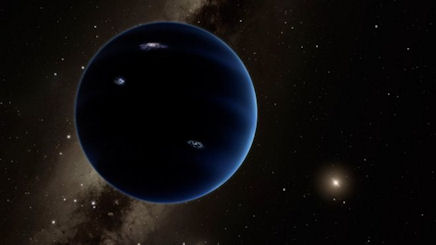
Image Credit: Caltech
For instance, these relate to efforts to narrow down the possible position of Planet X:
Trying to Constrain the Orbit of P9 by Imposing Resonant Configurations for the Most Distant TNOs
Dynamical Constraints on the Existence of Distant, Massive Planets in the Solar System
Stability Simulations to Constrain the Sky Location of Planet
Current Constraints on Planet 9 from Cassini Ranging Measurements
One of the topics has already resulted in a paper, released at the end of July, on the feasibility of a Resonance-based Planet Nine Search. This seems to provide a rather negative conclusion about the prospect of using mean-motion resonance relationships to help determine the position of a large planet affecting these scattered objects beyond the Kuiper belt (2). The complexities involved in trying to constrain the position of Planet Nine through simulation involving mean-motion resonances has been considered by another research team who contributed to the workshop. They highlight the role that chaos and resonance overlap play, painting a similarly cautious picture about the chances of nailing down this elusive object through such means (3). Yet, the possibility that it exists remains, at least theoretically. Its eccentricity and inclination can have variable effects upon how the Kuiper belt and scattered disk should look today (4). Indeed, a high inclination provides the 'cause' underlying the 'effect' of 2015 BP519's orbit, tilted at a massive 54 degree. this is a problem begging for the presence of a perturbing planet.
There was also plenty of discussion about different ways of finding Planet Nine at the workshop (5). Reflected light from an object 1000AU away is incredibly dim:
"At an orbital distance of 600 astronomical units (1 AU is the distance between Earth and the sun), Planet Nine would be 160,000 times dimmer than Neptune is at 30 AU. At 1,000 AU, it would appear more than 1 million times weaker." (5)
Finding such an object in visible light is therefore extremely difficult. Use of infra-red telescopes is one way of finding a relatively warm object compared to background. Scanning in the millimetre part of the electromagnetic spectrum might also have more luck in the future.
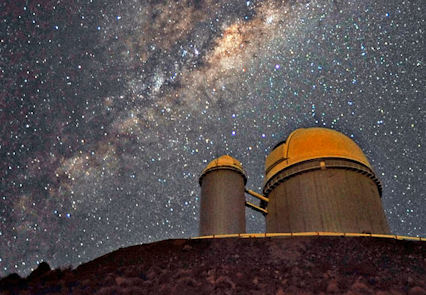
Astronomers study the sky using microwave detectors, usually using this part of the spectrum to investigate the chemical composition of enormous, cold gas clouds in space. Plans to create a ground-based cosmic microwave background (CMB) experiment, dubbed CMB-S4, in the Antarctic, the Chilean Atacama plateau, and maybe also a northern hemisphere location or two, might pop out Planet Nine from the background noise. But these types of sensitive microwave background searches are some way off. I think this is moving along the right lines, though, because I think that Planet X-type bodies are likely to be wrapped up within cold nebulae (6). More on this in my new book, working title "Darker Stars"; to be published later this year.
Finding Planet Nine remains a quest which is fraught with challenges, and not a little frustration. I'm given to understand that, despite this, the Planet Nine team remain optimistic that a discovery will be made before the end of this autumn.
Written by Andy Lloyd,
29th August 2018
References:
1)
Konstantin Batygin "Planet Nine Workshop"2) Elizabeth Bailey Michael E. Brown and Konstantin Batygin "Feasibility of a Resonance-based Planet Nine Search", The Astronomical Journal, 27 July 2018, 156(2),
3) Sam Hadden et al. "Chaotic Dynamics of Trans-Neptunian Objects Perturbed by Planet Nine", The Astronomical Journal, 24 May 2018, 155(6)
4) Gongjie Li et al. "The Secular Dynamics of TNOs and Planet Nine Interactions" The Astronomical Journal, 156(6): 263, 14 November 2018
5) Charlie Wood "Why Can’t We Find Planet Nine?" 3 July 2018,
6) Andy Lloyd "The Cumulative Effect of Intermittent Interstellar Medium Inundation Upon Objects In The Outer Solar System" 02/2016, DOI: 10.13140/RG.2.1.5112.5526,
Proximal Planet Formation
Somehow or other (and it's by no means clear how), some exoplanet gas
giants whizz around their stars at great proximity. The hottest of
these objects so far discovered is an exoplanet named Kelt-9b. It
is a sub-brown dwarf of ~3 Jupiter masses. It's so close to its
parent star that its rotation is tidally locked, and orbits the star in
just 36 hours. The temperature of its 'dayside' is over 4000
degrees C.
Image Credit:
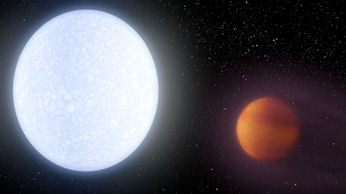
This remarkably high temperature is likely due to the immense amount of stellar radiation Kelt-9b is subjected to. This temperature and stellar irradiation is driving off huge amounts of hydrogen from Kelt-9b's atmosphere, creating an extended envelope of atomic hydrogen gas (1). Other similar tailed gas giants have been studied before (2,3). One can only imagine how spectacular this must look - a gas giant 'comet' streaming out a tail from near to or even within its parent star's extended corona.
New analysis of Kelt-9b's atmosphere has confirmed the presence of iron and titanium atoms within the planet's atomic chemical soup (4). It's known that brown dwarfs can have cloudy atmospheres containing liquid iron rain, as well as other atmospheric dusts (5). These dusty, cloudy atmospheres tend to form below 2,500 degrees Celsius, and then clear when the brown dwarf drops its temperature below about 1,500 degrees C.
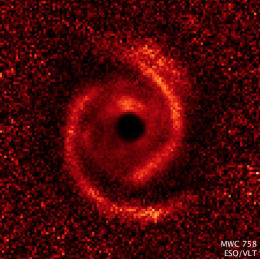
Image Credit: NASA/ESA/ESO/M. Benisty et al.
At the kind of temperatures Kelt-9b is experiencing, its planetary gases aren't forming clouds. Instead, they're dissociated into raw atomic elements. The entire atmosphere is a gaseous stew of various atomic elements, in neutral and ionised form. The lightest of these, hydrogen, is being constantly driven off by the bombardment of ultraviolet stellar radiation. This atomisation of gases allows astronomers the opportunity to study the composition of ultra-hot gas giants, as their elemental composition has not become tied up in a more complex brew of compounds. The light from the exoplanet already contains the raw elemental spectrometry. As time goes by, the exoplanet Kelt-9b is condensing into a denser atomic stew.
I wonder whether this planet once part of the star itself? This might seem an odd question, but the close proximity of hot Jupiters to their stars is an unexpected finding in planetary science. They also seem to be reasonably common. Were they planets which accreted out of the star's protoplanetary disk, and then migrated inwards towards the stellar furnace? Or, does the star itself somehow give birth to these proximal objects directly, as it forms?
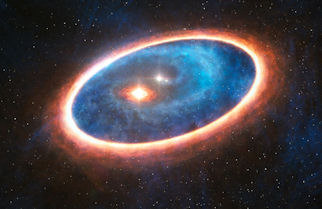
Image Credit: ESO/L Calçada
Stars are thought to form inside egg-shaped cocoons, called dense cores, within dense molecular clouds, or stellar nurseries. They appear to initially form as binaries within these dense cores, which then either retain their binary character, or separate into individual star systems (particularly if they started out as wide binaries) (6). Under certain circumstances, could the gravitational pull of the binary companion cleave materials away from a star during its formation? Or, might the binary twist the protoplanetary disk of the major into spirals, drawing out material from a star's atmosphere to create a hot Jupiter?
We are starting to appreciate how complex protoplanetary disks can become (7). Protoplanetary disk arms would be massive formations in their own right, and would be gravitationally powerful. They may be pulled out by an orbiting companion object, like a brown dwarf, or massive planet located towards the tip of the arm. At the star end of the spiral arm, the gravitational tug upon the star itself may contribute towards slowly spooling out a hot Jupiter object. Material can also stream towards a star within a binary system, moving between outer and inner disks (8,9). This process may also contribute towards building up an in situ ultra-hot planet very close to a star, prior to the exclusion of the binary companion.
Perhaps in the case of the sub-brown dwarf Kelt-9b we are witnessing a snapshot of a late stage in the process of proximal planet formation, taken some time after the ejection of a prior binary companion.
Written by Andy Lloyd,
16th August 2018
References:
1)
Fei Yan & Thomas Henning "An extended hydrogen envelope of the extremely hot giant exoplanet KELT-9b", Nature Astronomy, 2 July 2018,2) A. Lecavelier des Etangs et al. "Temporal variations in the evaporating atmosphere of the exoplanet HD 189733b", Astron. & Astrophysics, December 2012, 543: L4
3) B. Lavie et al. "The long egress of GJ 436b’s giant exosphere". Astron. & Astrophysics, September 2017, 605: L7
4) H. J. Hoeijmakers et al. "Atomic iron and titanium in the atmosphere of the exoplanet KELT-9b" Nature 560, 453–455,15 August 2018,
5) I. Crossfield et al. "A Global Cloud Map of the Nearest Known Brown Dwarf" Nature 505, 654–656, 2014
6) Sarah Sadavoy & Steven Stahler "Embedded binaries and their dense cores" Monthly Notices of the Royal Astronomical Society, 21 August 2017, 469(4): pp3881–3900,
7) Joshua Sokol "Stellar Disks Reveal How Planets Get Made" 21 May 2018
8) Hamish Johnston "Planet-forming stream found in binary star system" 31 Oct 2014,
9) Anne Dutrey et al. "Possible planet formation in the young, low-mass, multiple stellar system GG Tau A" Nature, 30 October 2014, 514: pp 600–602

You can keep informed of updates by following me on Twitter:
![]()
Or like my Facebook Page: https://www.facebook.com/darkstarandylloyd